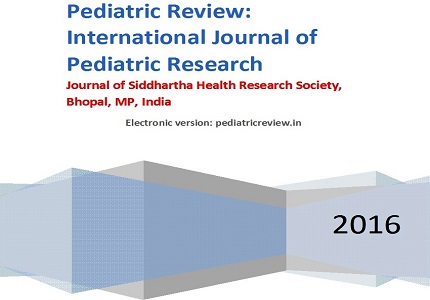Bacteriological profile and antibiotic sensitivity pattern of neonatal sepsis in a tertiary care hospital of northern India
Abstract
Introduction: Neonatal sepsis is the single most important cause of neonatal deaths in the community.
Objectives: To identify the common bacterial pathogens associated with neonatal sepsis and to identify their antibiotic sensitivity pattern.
Material and Methods: During the study period, all the neonates admitted in neonatology ward were screened for sepsis by physical examination and clinical features. All infants satisfying the criteria for sepsis were subjected for blood culture. Growths, if any were noted and standard antibiotic sensitivity was performed by the Kirby-Bauer disc diffusion method as per the CLSI recommendations.
Results: Out of 2520 neonates admitted in neonatal intensive care unit over a period of one year, 89 neonates were diagnosed as having septicemia. Incidence of sepsis in our hospital was 35.3/1000 neonatal admissions. Out of 89 clinically suspected and positive screening test cases of neonatal sepsis, 48.31% were culture proven cases of neonatal sepsis. Klebsiella was found to be the predominant pathogen (34.88%) of the culture positive cases followed by staphylococcus aureus in 32.5% and E. coli in 9.30% cases. Majority of the organisms were resistant to commonly used antibiotics like ampicillin, cloxacillin and ceftriaxone. Aminoglycosides were relatively more effective treatment modalities against gram negative organisms while vancomycin was the most sensitive drug against Staphylococcus aureus.
Conclusions: In view of growing bacterial resistance to commonly used antibiotics, knowledge of bacterial pathogens prevalent in NICU and their antimicrobial susceptibility pattern will help the clinician to select appropriate antibiotics for treatment of suspected neonatal sepsis cases.
Downloads
References
2. Mathur NB, khalil A, Sarkar R, Puri RK. Mortality in neonatal septicemia with involvement of mother in management. Indian Pediatr1991;28:1259-1263. [PubMed]
3. Mathur NB , Singh A, Sharma VK, Satya narayana L.Evaluation of risk factors for fatal neonatal sepsis. Indian Pediatr 1996;33:817-22. [PubMed]
4. Ohlsson A, Bailey T, Takieddine F. Changing etiology and outcome of neonatal septicemia in Riyadh, Saudi Arabia. Acta Pediatr Scand 1986;75(4):540-544. [PubMed]
5. Chacko B, Sohi I.Early onset neonatal sepsis. Indian J Pediatr 2005;72:23-6. [PubMed]
6. Chawla D,Agarwal R. Rational approach to diagnosis of neonatal sepsis. J Neonatol 2006;20(1):4-7. [PubMed]
7. Choudhury VP , Fazel MI , Choudhury M, Ghafary A. Neonatal infections and their outcome in Afghanistan. Indian Pediatr1987;24:1019-25. [PubMed]
8. Choudhury VP, Srivastava G, Aggarwal DS et al. Bacteriological study of neonatal infection.Indian Pediatr 1975;22:459-472. [PubMed]
9. Zaidi AK, Thaver D, Ali SA, Khan TA. Pathogens associated with sepsis in newborns and young infants in developing countries. Pediatr Infect Dis J. 2009 Jan;28(1 Suppl):S10-8. doi: 10.1097/INF.0b013e3181958769.
10. Datta S , Oberoi JK , Chugh TD. Laboratory diagnosis of neonatal sepsis. J Neonatol 2006;20(1): 16-23.
11. Niduvaje K, Amutha C , Roy J. Early neonatal streptococcal infection. Indian J Pediatr 2006; 73: 573-6. [PubMed]
12. Singh M. Neonatal septicemia. In: Care of the Newborn, 6th Edn , Sagar Publications, New Delhi 2004: 209-216. [PubMed]
13. Mustafa M, Laeeq Ahmed S. Bacteriological profile and antibiotic susceptibility patterns in neonatal septicemia in view of emerging drug resistance. J. Med. Allied Sci.2014; 4(1): 2–8.
14. Report of the Natonal Neonatal Perinatal Database (National Neonatology Forum) 2000.
15. Sharma PP, Halder D, Dutta AK et al. Bactriological profile of neonatal septicemia. Indian Pediatr 1987; 24: 1011-17. [PubMed]
16. K hatua SP , Das AK, Chatterjee BD et al. Neonatal septicemia. I ndian J Pediatr 1986;53:509-14. [PubMed]
17. Desai, K.J, Malek S.S, Parikh, A. 2011. Bacterial isolates and their antibiotics susceptibility patterns. Gujarat Med. J 2011; 66(1): 13–15.
18. Neonatal morbidity and mortality : Report of the National Neonatal Perinatal Database. Indian Pediatr 1997 ;34 :1039-42. [PubMed]
19. Neonatal morbidity and mortality : Report of the National Neonatal Perinatal Database. Indian Pediatr 1999 ;36 :167-9. [PubMed]
20. Karthikeyan G, Premkumar K. Neonatal sepsis :Staphylococcus areus as the predominant pathogen . Indian J Pediatr 2001 ;68:715-7. [PubMed]
21. Tallur SS, Kasturi AV, Nadgir SD, Krishna BV. Clinico-bacteriological study of neonatal septicemia in Hubli. Indian J Pediatr 2000; 67 :169-74. [PubMed]

Copyright (c) 2016 Author (s). Published by Siddharth Health Research and Social Welfare Society

This work is licensed under a Creative Commons Attribution 4.0 International License.


 OAI - Open Archives Initiative
OAI - Open Archives Initiative


